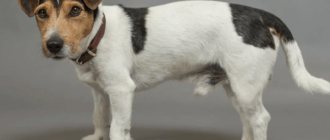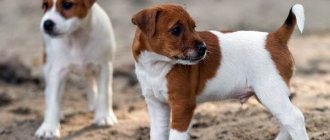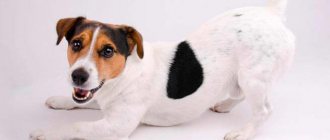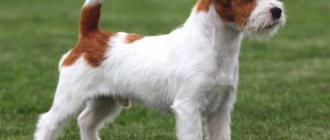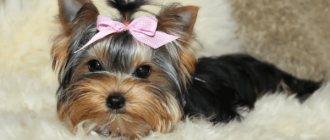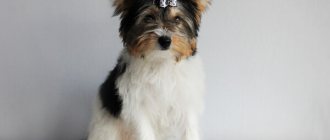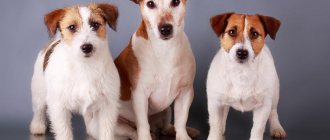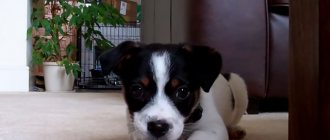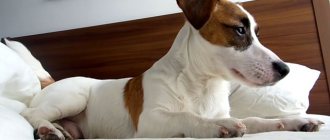Maintenance and care
You can keep a dog of the breed in question both in a city apartment and in a private house. However, practice shows that a pet of this breed feels more comfortable in its own home. The reasons for this are excessive activity and greater freedom during games and walks, which is allowed to pets living in country and private homes. Often, owners living in apartment buildings justify themselves by saying that the dog only needs to go out for a walk once a day.
In addition to walks, it is necessary to take the animal outside every time he wants to go to the toilet. In general, the animal adapts well to different climates; it loves to frolic in the sun in the summer and does not deny itself the pleasure of plowing through the fluffy snow in the winter. Many breeders take their dogs outside in warm clothes during the cold season. At the same time, the range of such products today is so diverse that you can easily choose an option, even taking into account the build and age of a particular pet.
From the first day of arrival in the house, the puppy should have its own place, as well as its own territory. This is a key rule of keeping, which accustoms the pet to understand the basics of upbringing. You can choose a place for the dog such that there are no drafts in its area. Also, it should not be in close proximity to heat sources (for example, you cannot “settle” a Russell Terrier by the fireplace).
The new family member should have his own dishes. In no close relationship should you make it from your own plates and bowls that are used by family members. If an animal eats and drinks from them, in the future they will be perceived as its property, which for some reason people use. There should also be no shortage of dishes: the dog should have three bowls: for dry food, liquid and water.
Care and hygiene must be regular: the animal is not able to wash and comb itself. A characteristic feature of dogs of this breed is the fact that they shed throughout the year if they are kept at home. However, wool does not cause much trouble if you get rid of dead hair on time. To comb terriers with hard hair, you need to purchase special trimmers called furminators.
These devices are convenient because, without much effort and in a short time, they can rid your pet of dead fur that prevents the growth of a new fur coat. Caring for the coat of other types of Russells is even easier: regular brushing is enough for them. As for washing, frequent water treatments are contraindicated for these dogs.
However, the lack of need for frequent bathing does not relieve the owner of the need for paw hygiene after every walk. Every time you come home, you need to wipe your dog’s paws with a damp towel or special wipes for animals. In addition, it is necessary to inspect them for cracks and wounds. In addition, we must not forget to check your pet daily for ticks and fleas that he may bring from a walk.
Ear and eye hygiene is carried out regularly. This must be done 2-3 times a month. Earwax is removed with a napkin soaked in a special product. If redness is detected in the area of the ears or eyes, the animal is immediately taken to an appointment with a veterinarian. In addition, the reasons for contacting a specialist may be discharge from the eyes and an unpleasant odor from the ears.
Dogs' teeth need to be brushed once a week. So that the pet does not resist such a procedure, it should be accustomed to it as early as possible. This should be done with special treats sold in specialized stores, as well as with the help of zoo paste and a brush for dog teeth. Pastes for people are contraindicated for dogs, as is brushing teeth with a finger with a fingertip on it.
If they stand up, this is considered a serious defect, and therefore, in order to prevent such a defect, they must be glued with a plaster. If the situation is advanced, you have to solve the problem surgically.
Feeding
The daily recommended diet is 1 to 1.5 bowls of quality dog food, divided into two servings.
However, the amount of food an adult dog needs depends on his age, size, build and activity level. Every dog is different and needs different amounts of food.
Keep Jack in good shape by measuring his diet and feeding him twice a day. If you think he is overweight, then do a little test. First, look at him. You should see his waist. Then place your palms on the back of the Jack Russell, with your thumbs along the back and your fingers along the ribs. You shouldn't see his ribs, but you should feel them with a little effort. If you do not feel them, then the dog needs additional physical activity and less food.
Choosing a place and utensils for feeding the puppy
The puppy eats quickly and a lot, despite its modest size. It should be taken into account that eating for a Jack Russell is a passing activity; the puppy quickly runs up to the bowl, swallows what is in it and switches to a more interesting activity.
What should you pay attention to when choosing a place and utensils for feeding?
- In order to prevent diseases, the puppy's eating area should be clean.
- In order to prevent injury, care must be taken to ensure that the student does not slip when running to the bowl, even if the floor is wet.
Important! When choosing bowls, it is better to give preference to models with low sides. The bowl should be made of ceramic or stainless steel. It is better not to use plastic accessories.
Care
Representatives of this breed are quite unpretentious in care. As mentioned above, Russells differ in the type of coat, and therefore the care of each type has its own characteristics.
Smooth-haired dogs are the easiest to care for, but they also shed more heavily than their wire-haired counterparts. The coat is brushed once a week with a coarse bristle brush. You can also use a special massage glove to improve blood circulation and relaxation. Wire-haired dogs need trimming - plucking out mature hair that does not fall out easily on its own. The procedure is quite labor-intensive and requires certain skills, so it is often entrusted to a specialist. It is recommended to carry out water procedures as needed, approximately once a month. Most of the Jack Russer Terrier's coat is white, but it always remains clean as it has the ability to self-clean.
It is also recommended to pay attention to dental health, especially if the dog eats natural food. It is necessary to provide it with special cleansing bones
You should also use a special paste and brush to clean your teeth, and this should be done at least 2 times a week. You should clean your ear several times a month. This can be done using special sanitary napkins and sticks.
Caring for puppies
Jack Russells usually give birth to 3–5 puppies in a litter, but some females give birth to 6 puppies. Newborn puppies feed on their mother's milk for the first month of life. After reaching this age, they need to gradually introduce complementary foods.
Jack Russell Terrier weight and height table by month
The age when a dog stops growing is different for each breed. Jack Russells typically grow until they are 11 to 12 months old. To properly assess your puppy's development, you need to carefully monitor its weight and height in the first year of life: use the table below for this:
| Age, months | Weight, kg | Height, cm |
| 1 | 0,7–1 | 8–9 |
| 2 | 2 | 10 |
| 3 | 2,5–3 | 11 |
| 4 | 4 | 12 |
| 5 | 4,1 | 13 |
| 6 | 4,3 | 15 |
| 7 | 4,5 | 17 |
| 8 | 4,6 | 19 |
| 9 | 4,7 | 20 |
| 10 | 4,8 | 22 |
| 11–12 | 5–6 | 25–30 |
From one and a half to 4 months, babies grow very actively, gaining height and weight, so their growing bodies require a large amount of nutritious food. If during this period the baby moved to a new home, at first it is advisable to feed the puppy the food that the breeder gave him. After the baby gets comfortable, you can change the type of feeding. If the owner chooses a natural method of feeding at this age, it is necessary to gradually introduce complementary foods into the puppies’ diet.
A 4-month-old Jack Russell Terrier continues to grow its body and internal organs. At this age, the puppy's baby teeth fall out and permanent teeth grow, and fur formation also occurs. From 4 to 6 months, the foods in the diet remain the same, but the number of feedings decreases and the volume of portions increases.
From 6 to 12 months of age, puppies grow less - at this time their bones become stronger and muscle mass increases, so the calorie content and volume of food can be reduced by reducing the amount of cereal given to the pet.
Feeding table for Jack Russell by month in the first life with a daily menu:
| Age, months | Menu for the day | Number of feedings |
| 0–1 | Mother's milk | 7–8 |
| 1–2 | Milk, soaked dry food, broth | 7 |
| 2–3 | Boiled lean meats, cereals, vegetables, fruits, dairy products | 6 |
| 4–5 | Meat, cereals, vegetables, dairy products, fruits | 4 |
| 6–12 | Meat, fish, cereals, vegetables, dairy products, boiled egg yolk, fruits | 3 |
Caring for a Jack Russell Terrier puppy from the moment it arrives in the house should be carried out according to certain rules:
- The baby’s place should be away from heat sources and drafts;
- it is necessary to purchase a sufficient number of toys for the puppy, which will be located next to his bed, as well as bowls, a leash, a muzzle, and a massage mitten;
- You can only walk your Jack Russell Terrier puppy on a leash;
- up to a year old, small Jack Russells should not go down stairs due to the risk of damage to their elbow joints;
- puppies can be walked only after they have received all the necessary vaccinations;
- you should not wake the baby unless necessary, since sleep is important for the formation of his nervous system;
- Until 5 months, Jack Russell puppies should not be left alone - at this age they find it difficult to tolerate loneliness, perceiving it as punishment.
Useful video
In this video you can watch a video about Jack Russell Terrier puppies.
The happy owner of a Jack Russell Terrier puppy must understand that he is responsible for how his dog will grow up . Proper feeding and purchasing the best vitamins and the most beautiful collars cannot replace a dog’s many hours of daily walks.
Only during joint games or training does mutual understanding and friendship, respect for the owner, and recognition of his leadership arise and strengthen.
Upbringing
Puppies strive to dominate from an early age, so it is necessary not to miss the right moment and stop trying. As soon as the baby appears on the doorstep of the house, it is necessary to teach him what is allowed to do and what is not allowed in his behavior. Especially the dog should know its place and not try to use affection and amusement to occupy the owner’s bed. Attacks, begging, and other attempts must be immediately and firmly prohibited. Parson loves to test his owner's strength and authority: having noticed compliance, he will immediately take the leading position. When traveling by car, you should not seat your dog in the front so that it does not feel its equal rights.
During walks, a representative of the breed will try to dig a flower bed, so from the first walks it is necessary to accustom the animal to etiquette; as well as from the habit of barking at other, especially large dogs - this will protect both the health and life of the terrier.
The third month is the intensive development of the puppy
Around the ninth - eleventh week, the dog remembers everything very easily. This is the best time to start training. The baby strives to understand the world around him; he, like a sponge, absorbs all the information and quickly learns everything. And he does it with pleasure, perceiving it as an entertaining game.
When training your dog, never use a system of punishment for unwanted behavior. The physical punishment and pain that the puppy feels can remain in his memory for the rest of his life. This will affect his attitude towards the owner and people in general.
The owner's requirements must be consistent and understandable, otherwise the animal will not learn the rules of the house. You can now take your baby with you for a walk. During which you need to stroke him often and play with him. Training sessions should not be long in time. Focus on your pet. Work on teaching commands as long as he is focused. Always reward your student for every exercise performed correctly.
A little history or how the Jack Russell Terrier breed appeared
Jackies were originally bred to hunt small and medium-sized burrow game: badgers, foxes and various water rats, such as muskrats.
They appeared at the beginning of the 19th century and got their name thanks to the English preacher and great hunting enthusiast John Russell.
Why were the first terriers white?
Initially, all these dogs were exclusively white. Do you know why?
In the century before last, burrow hunting became very popular in England. First, the beast was driven by a fleet-footed pack of fonkhounds. And when he hid in his hole, the fearless jacks came into action.
A small but strongly built dog had to drive the fox underground, and then pull it out after a fierce fight.
And so, in order not to confuse a dog with an animal even at a distance, only white terriers were used for hunting.
Fox Terrier - the ancestor of modern Russells
At first, the appearance bore little resemblance to the modern breed. All that was required of the dogs was obedience, courage, endurance and short stature in order to feel free in the hole.
And only the most meticulous breeders paid attention to the appearance of the animal. For example, erect ears were then a sign of a defect
How is a Russell similar to a bulldog?
As a result, these dogs began to develop aggressive fighting qualities that were unusual for a hunting breed. Fortunately, these dogs later did not gain the love of either breeders or owners.
But still some light jacks with bright dark spots have the genes of those same bulldogs.
Such dogs are distinguished by an unusually wide head and a squat “bulldog” build. But their main difference is the absence of the usual “bell”: they do not have a cocky loud bark, which is simply necessary when hunting.
How to choose a puppy?
As with many breeds, the Jack Russell has certain standards that you need to familiarize yourself with so as not to be deceived.
You also need to pay attention to the following:
- the puppy should be active and mobile, look cheerful. Avoid shy and indifferent dogs;
- length and height should be proportional. The puppy's structure should be proportional;
- According to the standard, the dog's head should be of medium width and taper towards the eyes and ears. The nose should be black, the eyes should be black almond-shaped, and the jaw should be strong. The ears should be V-shaped and close-fitting;
- check the dog's appearance and proportions. Are there any external defects? The puppy must have an athletic appearance;
- from the rear, even a puppy should look strong and muscular. The tail should be set high. A healthy puppy always wags him happily;
- pay attention to the wool. If the puppy is smooth-haired, check for fine spots. A long-haired puppy or brocken should not look fluffy. 51% or more of the color must be white. Acceptable colors are red, black and brown shades;
- The puppy's gait should be lively and even.
Breed characteristics, behavioral characteristics
This breed is characterized by its small stature, which allows the animals to easily crawl into holes and move nimbly through them. Russell walks with a springy, relaxed gait, his strong paws provide him with high speed and running time in pursuit of game. Its strong jaws and strong fangs provide a reliable grip on prey, both underground, on land and on water. As mentioned above, this breed is characterized by a light or white color with dark or brown spots.
If you decide to get your own pet Russell Terrier, you will most likely find a cheerful, loyal and friendly companion. He will be happy when all your household members get together. Four-legged friends love to take walks with you for company and willingly play outdoor games with their owner. They are characterized by extraordinary activity and liveliness of nature.
Let's name a few more characteristic character traits:
- Russell is cheerful, friendly to his owners, and willingly plays with them. And he does not lose these qualities until old age. Like other small breeds (dachshund, beagle and others), with proper care, the Russell can live up to 15 years, but even in his “retirement” years he will not stop entertaining household members with his gaiety.
- This breed is brave and can behave independently, which sometimes causes difficulties in training.
- The Jack Terrier is friendly towards children and is not aggressive towards strangers - but only if it is raised properly.
- A powerful hunting instinct forces him to rush at cats and other small animals, including those he saw on the street. All these creatures are just likely prey, and the dog is able to attack them to make them prey.
- The breed is characterized by curiosity, and the boring and monotonous life of Russells is depressing. They need a rotation of vivid impressions to satisfy their interest in the world around them.
- They are distinguished by endurance and restlessness. Therefore, it is better to get a Russell not for those who prefer to lie down or live at the computer most of their free time. The best owner is a restless person or a family in which it is customary to constantly move, play, travel, and work in the fresh air. Terriers need exercise to stay healthy.
Continuation of training (4-6 months)
The dog should know a basic course of basic commands by 6 months. Having taught the pet the commands from the previous paragraph, the owner proceeds to the following:
- “Show your teeth!” The owner says: “Show your teeth,” while placing his right hand on the lower jaw, and his left hand on the upper jaw. Unclenches lips, not allowing jaw to move apart;
- "Voice!". When the pet starts barking, the owner says a command and praises the pet. After several repetitions, the pet will get used to it and begin to bark on command;
- "Walk!". Most often used as a reward after completing other commands. It’s easy enough to pat your pet on the back, say “walk” and let him go;
- "Stand!". The owner brings the pet to him, pronounces the command, pushes him a little under the stomach so that he stands and listens. After this, reward with a treat. If the dog lies down, pick it up by the fur. After completion, release the dog with the command “Walk!”;
- “Crawl!” This is a rather difficult exercise, as it involves a large number of muscles that are not used in everyday life. This command can be learned after an emotional connection has already been formed between the owner and the dog. The owner orders the pet to lie down, and he squats in front of him, holding his hand with a treat close to the ground. After the command “Crawl!” the pet should gradually crawl towards the owner. When he crawls about 20 cm, you should reward the dog. With each lesson the distance increases;
This is how the command “Crawl!” is executed.
- "Forward!". It is practiced on the street near a narrow passage. The owner approaches a ditch/hole/narrow stream and throws a wide board over it. The owner gives the dog standing nearby a treat to sniff, then commands “Forward!” and throws the treat, throwing out his hand, palm down. When the dog runs for a piece and finds it, it is rewarded with a gentle voice and a second piece of treat;
- "Wait!" Having learned the command, the pet will be able to remain motionless until ordered to leave. The owner calls the pet to him, orders him to sit or lie down, after which he commands “Wait!” and holds it with his hand. After a couple of minutes, give the dog a treat and command “Walk!”;
- Also at this age it is time to teach the puppy to give the object clenched in his teeth to the owner when he asks. This is done with the command “Give it back!”, after which you need to carefully take the thing and press the dog to the ground with both hands - by the head and croup. This way he will quickly get used to discipline and understand who is in charge in the family.
Jack Russell Terrier plays frisbee with owner
Nutrition
A natural diet should consist of the following products:
| Recommended diet | |
| Lean meat, offal (offal, liver, cartilage) | In addition to chicken meat, which causes allergies |
| Kash | Buckwheat, rolled oats, rice |
| Vegetables | Pumpkins, carrots, beets |
| Fruit | Apples |
| Fermented milk products | |
| Egg yolk |
For example, it is useful to give your pet carrot and apple salads seasoned with sour cream.
From two months you need to add to your daily diet:
- Chondroitin.
- Fish fat.
- Calcium.
You can entrust the selection of useful substances to a veterinarian. When training, the animal is encouraged a little with rye crackers, hard cheese, and dried apples. Parson is prohibited from:
- Legumes, especially corn.
- Semolina.
- Onion and garlic.
- Citrus.
- Smoked.
- Grape.
- Sweets.
- Sausage.
- Nuts.
- Mushrooms.
- Pepper.
Although Russells give the impression of being very active dogs, they should not be fed. Healthy adult dogs should eat twice a day; at 2-4 months the puppy needs to eat 5 times a day, from 6 months - 4 times, at 10-12 months - 3 times.
How to feed?
The Jack Russell should eat from a bowl on a special stand that can be adjusted as the puppy grows.
Don't feed him from the table, even if he asks. Accustom your dog to a routine - to eat in a certain place at a certain time.
If you decide to feed your puppy natural food, make sure that he receives all the necessary substances and that the diet is balanced.
Food should be at room temperature.
From 4 months, you need to feed your puppy six times a day, reducing the number of feedings every month. After 9 months, the dog should eat 2 times a day.
Make sure your dog always has fresh water at room temperature.
Training
Russells are trained depending on the purpose for which they purchased the dog. A hunting dog is raised by one set of rules, a companion by another. Hunting skills are best developed by specialists in canine organizations. This is a rather difficult process that develops in the dog courage, perseverance, and the ability to make decisions. A domestic Russell is a completely different matter. They are quite obedient, but it is forbidden to tease the dog, and you cannot use methods such as beating and screaming in training. It is best to use the incentive method.
For more information about the characteristics of this breed, see the following video.
Factors influencing growth
It is much easier to ensure the harmonious development of your Jack Russell Terrier if you know the main factors affecting the pet’s height and weight. Their most serious influence is in the period from birth to 1 year of life.
Thus, developmental delay is most often caused by the following:
- Congenital, hereditary diseases.
- Poor quality, insufficient, low-calorie nutrition.
- Poor living conditions - cold, damp, drafts, constant noise, systemic stress.
- Worm infestation.
- Poor living conditions for the mother dog during pregnancy and lactation.
- Untimely, incorrect introduction of complementary foods, too early weaning from mother's milk.
- Insufficient level of lactation in the mother dog during the suckling stage of the puppies' life.
- Lack of supplements of vitamins and microelements necessary for cuties.
- Insufficient or, on the contrary, excessive, debilitating physical activity.
To restore the harmonious development of the puppy, it is better not to let the problem take its course, and not to try to fix it yourself without the necessary education and experience. The best option is to seek help from a veterinarian. Depending on the source of the problem, the solution is found:
- Deviation from the norm during the suckling period. The kitten is placed on the dog's rear nipples, where more milk collects. This situation is typical for multiple litters: stronger puppies push the weaker ones away from the nipples. If there is not enough milk for everyone, then artificial nutrition is introduced and a nurse dog is found. When the puppies are already grown up, with the approval of a specialist, they are introduced to complementary foods ahead of schedule.
- Underweight after purchasing a puppy. Perhaps this is how stress affects the baby - a new home, separation from his mother and siblings. The new owner must surround the baby with attention and care, adjust his diet: add calcined cottage cheese with one yolk, a couple of spoons of whey and 2 drops of a multivitamin.
- Developmental delay is a consequence of helminthic infestation. If the conditions for keeping the animal are ideal, the diet is correct, the reason for the low weight may be helminths. The necessary tests are carried out, the puppies are prescribed Dirofen, Prazitel, Helmintal, etc.
The right diet
Keeping jacks involves not only hygienic care, but also proper timely nutrition. A healthy diet is the key to strong bones, a strong immune system, energy and good mood.
You can feed Russells with ready-made dry food. It is convenient to store, transport, pour and easily measure the required amount. In addition, the granules contain the necessary complex of vitamins and minerals.
But low-quality dry food leads to gastrointestinal imbalance and serious health problems. Therefore, it is better to opt for super-premium products for small active breeds.
Natural nutrition should consist of raw (thawed or scalded) lean meat and complex carbohydrates. Chicken, turkey, beef, rabbit are suitable. By-products can be used. Not all Russell Terriers love fish, but you can pamper your Jack with seafood.
Allowed cereals:
- oatmeal;
- buckwheat;
- barley porridge.
Vegetables:
- carrot;
- zucchini;
- beet.
If Russell loves fermented milk products, then you can add kefir, cottage cheese, fermented baked milk, and sour cream to the diet.
One of the features of keeping Jack Russell puppies is feeding them 4–5 times a day. Up to 3 months, babies are fed 5-6 times, up to 5 months - 4 times, only by the age of one year are they transferred to two meals a day. The serving size is determined by the formula: 20 g of food per 1 kg of Russell Terrier weight.
Price range
How much does a Jack Russell puppy cost?
The highest price for a dog is set when the dog is 5-6 months old. The lowest price is for a puppy one and a half months old.
This is explained by the fact that both its advantages and disadvantages are already visible in a grown-up puppy. If you take a baby, you are literally playing the lottery.
Based on this information, the standard price range for a Jack Russell Terrier puppy ranges from 20 to 40 thousand rubles, taking into account pedigree and vaccinations and provided that you take the puppy from an experienced breeder.
If this information is not important to you, then in this case the price for a Jack Russell starts at 10 thousand rubles.
Breed characteristics
| Short description | |
| Origin: | Great Britain |
| Conditions of detention: | In an apartment/in a house |
| Purpose: | Mainly a working hunting dog, with proper training can be successfully used as a companion dog |
| Color: | White, red, yellow or black spots allowed, mainly on the head or tail |
| Wool length: | Short, less than 5 cm, bristly, with undercoat |
| Adult dog size: | Weight: 6-8 kg Height: 33-36 cm |
| Average life expectancy: | 13-15 years old |
| Walk: | Long walks required, 2-3 times a day |
| Physical activity needs: | High, requires daily, active games lasting at least 1 hour with high intensity |
| Fédération Cynologique Internationale (FIC) classification: | Recognized by the FCI in 2001 Group 3. Terriers/Section 1. Large and medium terriers |
| Puppy price: | Without breeding rights - 15-25 thousand rubles For exhibitions and mating - 35-45 thousand rubles |
Character traits
If we compare representatives of this breed with other terriers, the former have a significant difference in the form of balanced behavior. They often cuddle up to their owner, rarely raise their voices, but they are very willing to learn and are ready to follow a person anywhere. Unpretentiousness and endurance are also characteristic of Jack Russells.
If there is sufficient physical activity, the owner will not have any problems with his pet. It is worth considering that the dog is quite independent and has a decisive character. They also enjoy taking part in various games.
Positive results in training can only be achieved through patience and perseverance.
If there are children in the house, the terrier will be very friendly towards them. Especially in cases where they live together from an early age. A dog can be aggressive towards members of its own species. To avoid this, it is necessary to carry out socialization at the earliest possible stages.
The hunting instincts of Jack Russells have not gone away, and therefore if there are also small pets in the house, then, in most cases, conflict situations arise. This especially applies to rabbits and decorative rodents; cats can also suffer.
This breed needs to be constantly occupied with something. When a four-legged pet begins to feel bored, it will begin to cause damage to the home interior:
- chews household items;
- digs floors;
- voices often;
- begins to demonstrate uncontrollable behavior.
Jack Russells require constant training, and it is also recommended to enroll dogs in various competitions.
Some owners make the mistake (due to the small size of the dog) and believe that the terrier will make an excellent indoor dog. Here everything will come down to hunting instincts, the animal will show curiosity and activity. Older people often cannot cope with such dogs, and therefore it is worth carefully weighing the pros and cons when choosing a Jack Russell.
If you miss raising your pet, then it will be inappropriate for him to show his independence. Terriers have a rather wary attitude towards strangers, but they show aggression towards their own kind. Chasing cats is a favorite activity, so when walking, it is recommended not to let the dog off the leash; you can give free rein to your pet in a quiet and familiar place.
If there are two terriers in the same apartment, they should not be left together. The showdown will begin immediately. Due to their hot temper, Jack Russells are jealous of their territory, and generally consider their owner to be their property.
The energy of dogs is evident in everything; a short and uninteresting walk will lead to the fact that at home the pet will find entertainment in the form of encroaching on the integrity of the owner’s things. When keeping in a country house, it is worth taking into account the jumping ability of small hunters; rather high fences will not always become a hindrance for them. If it is not possible to jump over, the terrier will be happy to dig under the ground.
A dog should not be left without education; representatives of this breed need intellectual stimulation. A lively mind allows pets to learn easily, but sometimes they begin to be stubborn. It is recommended to alternate commands, and do not forget about positive reinforcement in case of successful execution of the order.
Parson Russell Terrier breed standard
Parson Russells are very similar to Jack Russell Terriers, which is no coincidence - the breeds have common ancestors, and until 2001 they generally had to share one standard of appearance between two. And yet there are exterior differences between representatives of both families. For example, Parsons are slightly taller than Jacks and have an almost square body shape, while their counterparts have a distinctly rectangular body. Leg length is also considered a breed characteristic. Parson Russell Terriers have longer limbs than the stocky, compact Jack Russells.
Eyes
Parson Russell Terriers are characterized by deep-set, almond-shaped eyes with dark-colored irises. The dog's gaze is inquisitive and soulful.
Ears
The ear flap is small, perfectly triangular in shape, hanging forward. The tips of the ears almost touch the outer corners of the eyes.
Neck
The neck of a purebred individual should be muscular and gradually widen towards the shoulder girdle. The pronounced massiveness of this part of the body is not welcome.
Frame
The Parson Russell Terrier has an almost square body with a strong back, a slightly convex loin and a normal chest depth, located above or at the level of the dog's elbows.
The Parson Russell's front legs are straight, strong, with long shoulder blades pointing back and elbows tightly pressed to the body. The hind legs are muscular and well angulated, with the hock joints located very low. The animal moves sweepingly, freely, energetically.
Tail
Working Parson Russell Terriers have their tails docked, so this part of the body can only be viewed in its natural form on show dogs (canine associations in Europe have vetoed the docking procedure). A natural tail should be perfectly straight, powerful, set relatively high, and held vertically when moving. The docked tail should not be too short so that, if necessary, the owner can grab it with his hand, removing the carried away pet from the fox hole.
Wool
The Parson Russell Terrier can be either slightly shaggy or smooth-haired. The coat itself is coarse and thick, which is a necessary condition for hunting breeds - a dense layer of hair protects the dog’s body from bites and scratches of wild animals.
Color
Parson Russells are either completely white or white with red, black and yellow spots. Moreover, it is preferable if the spots are located on the head or at the base of the tail.
Defects and disqualifying defects
Individuals whose appearance does not fit into the framework specified by the standard are considered defective. In particular, dogs with an incomplete set of teeth, incorrect structure of the body and paws, as well as with a light-colored iris will be rejected by the show judges or will receive a low score. Animals with an unstable psyche, as well as Parson Russells with too conspicuous defects in appearance, indicating a dubious pedigree, are subject to complete disqualification.
Read with this
- Without unnecessary noise
- Parson Russell Terrier
- How to toilet train a dog using a diaper
- Can your dog swim? Why Some Dog Breeds Can't Swim - Tips for Pets - 2020
- How to sew a blanket for a dog with your own hands
- Operant method of dog training
- The best dog breeds suitable for older people
- How to transport a dog on a train? new rules of Russian Railways on the transportation of animals
- Puppy Development Stages with Growth Charts and Weekly Week - Puppy Project
- We learn to determine the health status of a pet by the temperature of its nose
Brief information about the breed
Dogs of this breed were bred in Great Britain for burrowing . The breed combines small size, strength, courage and powerful jaws. All this was needed to penetrate the hole and grab prey.
Nowadays, the Jack Russell Terrier has an average weight of 5-7 kg, and a height at the withers of 25-31 cm. The skull is slightly narrowed towards the eyes. The eyes themselves are shaped like almonds, dark and deep-set. The chest has a girth of 40-43 cm, the tail is docked. The life expectancy of dogs of this breed with proper care is on average up to 14-15 years.
From the first days, Jack Russell Terrier puppies are characterized by excessive activity and a desire to dominate their owner, therefore, in order to turn a Russell into a well-mannered dog, you will have to make a lot of effort. Raising a Jack Russell should take place without shouting and beating, but at the same time without indulging in all the dog’s pranks, which will turn the puppy into a real little devil in the future.
To prevent bad behavior, you need to stop any antics of your pet, not be touched by his pranks, and not allow the dog to become the main one in the house and manipulate you.
